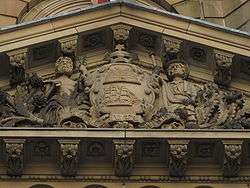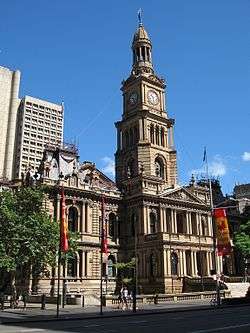Sydney Town Hall
| Sydney Town Hall | |
|---|---|
|
| |
|
The Town Hall, pictured in 2006. | |
| Alternative names | Town Hall, Centennial Hall, Main Hall, Peace Hall, Great Hall, Old Burial Ground |
| General information | |
| Status | Complete |
| Type | Town hall |
| Architectural style | |
| Location | 483 George Street, Sydney CBD, New South Wales |
| Country | Australia |
| Coordinates | 33°52′24″S 151°12′23″E / 33.873235°S 151.206323°ECoordinates: 33°52′24″S 151°12′23″E / 33.873235°S 151.206323°E |
| Construction started | 1886 |
| Opened | 1889 |
| Renovated | 1991-92 |
| Renovation cost | A$15.5 million |
| Owner | Council of the City of Sydney |
| Technical details | |
| Material |
|
| Floor count | 2 |
| Lifts/elevators | 1 |
| Design and construction | |
| Architect | John H. Wilson |
| Other designers |
|
| Main contractor |
|
| Designations | |
| Known for |
|
| Other information | |
| Seating capacity | 2,535 (Centennial Hall) |
| Website | |
|
www | |
| [1][2][3] | |
The Sydney Town Hall is an Australian heritage-listed town hall building located in the central business district of Sydney, the capital city of New South Wales. Constructed primarily of Sydney sandstone, the landmark building is located on George Street, opposite the Queen Victoria Building and alongside St Andrew's Cathedral. Sited above the Town Hall station and between the city shopping and entertainment precincts, the steps of the Town Hall are a popular meeting place.
The Town Hall is listed on the Register of the National Estate[1] and the NSW State Heritage Register[2] and is part of the important Town Hall group of heritage-listed buildings, which also includes the Queen Victoria Building, St Andrews Cathedral, the Gresham Hotel and the former Bank of New South Wales.[4]
In popular culture, the Town Hall resembles the fictional home of The Addams Family, as depicted in the 1964 TV series of the same name.
History and description
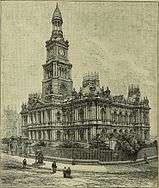
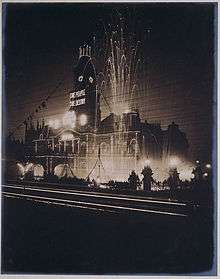
The Town Hall was built in the 1880s – on the site of the former Old Sydney Burial Ground. The cemetery was Sydney's first permanent cemetery and it is estimated that at least 2000 burials were made in the Old Sydney Burial Ground between 1782 and 1820.[3]
The Town Hall was built from local Sydney sandstone in the grand Victorian Second Empire style,[1] inspired by the French Second Empire Hotel de Ville in Paris.[3] The Town Hall has been described as having "lavishly ornamented composition with focal tower and fanciful roofs".[5] The building consists of the original Town Hall, mayoral suites and town clerk's offices. These were designed by J. H. Wilson in 1866, having won a civic competition to design a town hall for the rapidly-growing city. Construction of his initial designs were completed under the architectural direction of Albert Bond in 1869.[6] Wilson also designed the interior of the original Town Hall meeting room. The clock tower was completed in 1873[6] to the design of E. and T. Bradbridge and whose clock was installed in 1884. The Centennial Hall and associated offices and entrances were designed by Thomas H. Sapsford in 1883,[6] but after his death were completed by architects David McBeath, John Hennessy and George McRae in 1889.[1]
The Town Hall remains the only non-religious city building from the era to retain its original function and interior. The building houses the Sydney City Council Chamber, reception rooms, the Centennial Hall and offices for the Lord Mayor and elected councillors.
The Centennial Hall contains the Grand Organ, the world's largest pipe organ with tubular pneumatic action, built from 1886 to 1889 and installed in 1890 by the English firm of William Hill & Son. The organ possesses one of only two full-length 64′ organ stops in the world (the Contra-Trombone in the pedal). Before the opening of the Sydney Opera House and its Concert Hall, the Town Hall was Sydney's premier concert hall, and many notable performances took place there.
In the later years, it has been discovered that Town Hall lies on top of part of a cemetery complex. Renovations were undertaken in 2008-9 primarily to upgrade the mechanical, hydraulic, electrical and communication services within the building. The renovations, completed by Sydney builder Kell & Rigby, included removing 6,000 cubic metres (210,000 cu ft) of sandstone from underneath the building.[7]
Present day
The Sydney Town Hall still serves as an important presence and meeting place for the city of Sydney to this very day. The building itself regularly undergoes cleaning and restoration to preserve it for future generations. Additionally, it has been rendered with sustainability by improving energy efficiency, including smart light censors, energy efficient lighting, new roofing insulation to moderate building temperature, solar panels, and new hydraulics and storm water infrastructure.[8]
Gallery
 The Centennial Hall with the grand organ
The Centennial Hall with the grand organ The domed ceiling
The domed ceiling Detail on one of the mansards
Detail on one of the mansards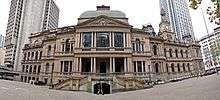 South side of building
South side of building Queen Victoria Building and Sydney Town Hall undergoing maintenance viewed from York St, August 2014
Queen Victoria Building and Sydney Town Hall undergoing maintenance viewed from York St, August 2014- Centennial Hall during state memorial service for Gough Whitlam
Sydney_Town_Hall_025.jpg) Sandstone lion on north side of building
Sandstone lion on north side of building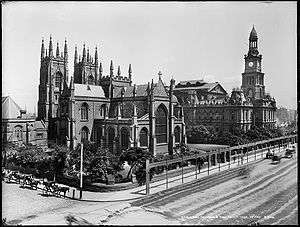 Sydney Town Hall as it appeared in the early 1900s facing north with St. Andrew's Cathedral to the left
Sydney Town Hall as it appeared in the early 1900s facing north with St. Andrew's Cathedral to the left
See also
References
- 1 2 3 4 "Sydney Town Hall (Place ID 1904)". Australian Heritage Database. Department of the Environment. 21 March 1978. Retrieved 23 September 2016.
- 1 2 "Sydney Town Hall". State Heritage Register. Office of Environment & Heritage, Government of New South Wales. 16 May 2003. Retrieved 24 September 2016.
- 1 2 3 "The site". Sydney Town Hall: Building history: Discover & learn. City of Sydney. 2016. Retrieved 24 September 2016.
- ↑ The Heritage of Australia. Macmillan Company. 1981. pp. 2, 100.
- ↑ A Pictorial Guide to Identifying Australian Architecture. Apperley. Angus and Robertson. 1994. p. 68.
- 1 2 3 "Construction". Sydney Town Hall: Building history: Discover & learn. City of Sydney. 2016. Retrieved 24 September 2016.
- ↑ "Old Sydney Burial Ground – City of Sydney". City of Sydney. February 2008.
- ↑ "City of Sydney: Sydney Town Hall". Retrieved 9 August 2015.
External links
| Wikimedia Commons has media related to Sydney Town Hall. |
- A short documentary on the lived history of Sydney Town Hall
- A history of Sydney Town Hall
- Official website
- "Building history". Sydney Town Hall. City of Sydney. 2016.
- "Sydney Town Hall (Place ID 1904)". Australian Heritage Database. Department of the Environment. 21 March 1978.
- "Sydney Town Hall". State Heritage Register. Office of Environment & Heritage, Government of New South Wales. 16 May 2003.
